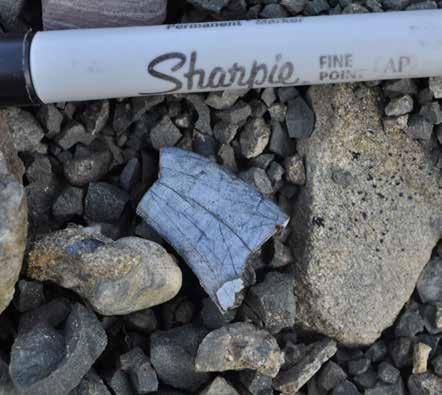
3 minute read
Dinosaurs of the Spatsizi Plateau
1.
Spatsizi Plateau Wilderness Provincial Park

The Search Continues In the summer of 2013, Royal BC Museum curator of botany Dr. Ken Marr spotted something interesting during his alpine fieldwork in Spatsizi Plateau Wilderness Provincial Park—a small, shiny tooth from a tyrannosaurid dinosaur, maybe even Tyrannosaurus rex.
By Dr. Victoria Arbour
Curator of Palaeontology
1. The 2019 expedition to the Spatsizi Plateau found an exciting site with dinosaur fossils, but a surprise August snowfall ended the field season early. Photograph courtesy of Thomas Cullen.
2. A serrated tooth from a tyrannosaurid dinosaur— perhaps even a Tyrannosaurus—found by curator of botany Dr. Ken Marr in Spatsizi Plateau Wilderness Provincial Park in 2013.
2.

Learn more about the dinosaurs of the Spatsizi Plateau on our Research Portal at
rbcm.ca/research-portal
Dr. Victoria Arbour points at a dinosaur bone embedded in a larger boulder in Spatsizi Plateau Wilderness Provincial Park during the 2019 field expedition. Photograph courtesy of Thomas Cullen.

When I joined the Royal BC Museum as the new curator of palaeontology in 2018, I was incredibly excited to learn more about this tooth, because dinosaur fossils had never been found in that part of BC before. The Spatsizi Plateau lies in the northern part of a geological region called the Sustut Basin; BC’s newest dinosaur, Ferrisaurus sustutensis (nicknamed “Buster”), was found in the southern part of the basin. Where there’s one tooth, there’s probably more. It was time to return to the Spatsizi Plateau and look for more dinosaurs!
In August 2019, my colleagues Jaclyn Richmond (the museum’s former acting palaeontology collections manager) and Thomas Cullen (then a postdoctoral fellow at the Field Museum) and I visited two sites where the 2013 team had found fossils. We spent several days at the first site hiking around and keeping our eyes peeled, but we didn’t find any more dinosaur bones or teeth. But after about an hour hiking along a cliff covered in rocky rubble at the second site, Jaclyn picked up a piece of what might be a small meat-eater’s leg bone! Then Tom held up a rock with another bone in it, and pretty soon we were finding dinosaur bones every few paces. Most of them were in big boulders and would have been too difficult to extract with the tools we had brought with us, but we were thrilled that we could collect some of the smaller pieces and make a plan for returning.
After a great afternoon of fossil discoveries, we headed back to camp, excited for what we might find during the rest of our stay. Nature had other plans: the next day it rained, and then it started snowing! After more than 24 hours of this summer blizzard, the rocky cliffs were covered in snow, putting an end to the expedition. I’m used to working in hot deserts when I’m on the hunt for dinosaur bones, so spending a few days camping in the snow on the side of a mountain was a new adventure for me. I can’t wait to get back to the Spatsizi Plateau to see what dinosaurs might be waiting for us in that beautiful part of British Columbia!
We are grateful to BC Parks for their financial and permit support for this research.
The Other Palaeo Diet
Dr. Victoria Arbour Receives a Prestigious Grant
By Erik Lambertson Corporate Communications Manager
Earlier this year, Dr. Victoria Arbour, curator of palaeontology, received a Natural Sciences and Engineering Research Council of Canada Discovery Grant through her adjunct appointment in the School of Earth and Ocean Sciences at the University of Victoria.
It’s an honour—as well as a tremendous opportunity to pay forward her considerable knowledge.
As Dr. Arbour points out, one of the major mutual benefits of the funding is that UVic students will have consistent access to the museum’s palaeontology collections. They’ll work alongside a world-renowned expert (that’s Victoria!) in the field, who will help train this new generation of scientists.











